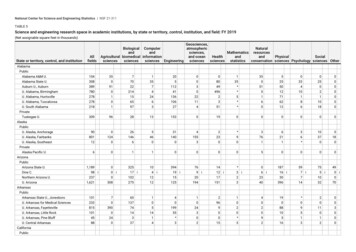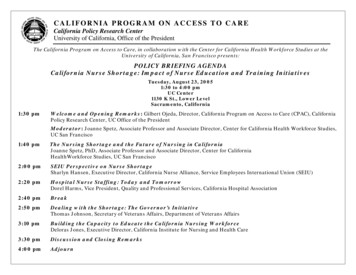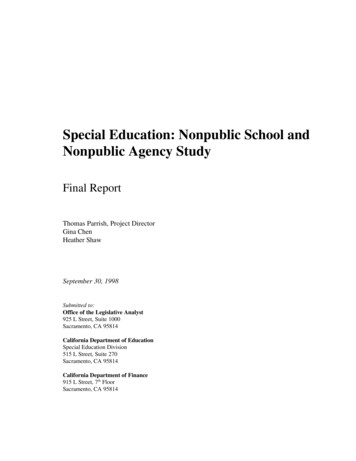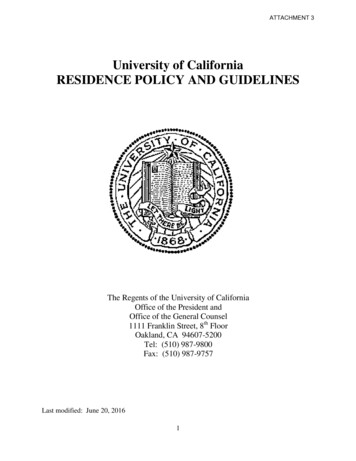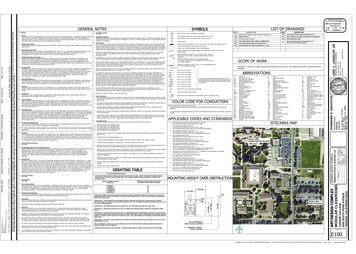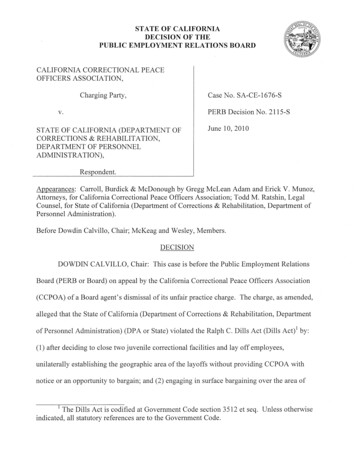
Transcription
STATE OF CALIFORNIADECISION OF THEPUBLIC EMPLOYMENT RELATIONS BOARDCALIFORNIA CORRECTIONAL PEACEOFFICERS ASSOCIATION,Case No. SA-CE-1676-SCharging Party,PERB Decision No. 2115-SSTATE OF CALIFORNIA (DEPARTMENT OFCORRECTIONS & REHABILITATION,DEPARTMENT OF PERSONNELADMINISTRATION),June 10, 2010Respondent.Appearances: Carroll, Burdick & McDonough by Gregg McLean Adam and Erick V. Munoz,Attorneys, for California Correctional Peace Officers Association; Todd M. Ratshin, LegalCounsel, for State of California (Department of Corrections & Rehabilitation, Department ofPersonnel Administration).Before Dowdin Calvillo, Chair; Mckeag and Wesley, Members.DECISIONDOWDIN CALVILLO, Chair: This case is before the Public Employment RelationsBoard (PERB or Board) on appeal by the California Correctional Peace Officers Association(CCPOA) of a Board agent's dismissal of its unfair practice charge. The charge, as amended,alleged that the State of California (Department of Corrections & Rehabilitation, Departmentof Personnel Administration) (DPA or State) violated the Ralph C. Dills Act (Dills Act) by:(1) after deciding to close two juvenile correctional facilities and lay off employees,unilaterally establishing the geographic area of the layoffs without providing CCPOA withnotice or an opportunity to bargain; and (2) engaging in surface bargaining over the area ofThe Dills Act is codified at Government Code section 3512 et seq. Unless otherwiseindicated, all statutory references are to the Government Code.
layoff. The Board agent dismissed the charge for failure to state a prima facie case ofunilateral change or surface bargaining.The Board has reviewed the dismissal and the record in light of CCPOA's appeal,DPA'S response and the relevant law. Based on this review, the Board affirms the dismissal ofthe charge for the reasons discussed below.BACKGROUNDCCPOA is the exclusive representative of State Bargaining Unit 6. In September 2007,the Governor signed Senate Bill No. 81, which realigned services for juvenile offenders byallowing certain juveniles incarcerated for less serious crimes to remain in, or be referred backto the counties. As a result of this bill, the Department of Corrections and Rehabilitation(CDCR) anticipated that the juvenile population housed by CDCR would drop to 1,840 byJune 30, 2008 and to 1,575 by June 30, 2009. Therefore, based upon this and other legislationand court decisions affecting CDCR's adult services, CDCR began the process of closing someof its juvenile detention facilities. In November 2007, CDCR developed preliminary plans toclose both the El Paso De Robles Youth Correctional Facility (El Paso) and the De Witt NelsonYouth Correctional Facility (De Witt) effective July 31, 2008. Given the language of SenateBill No. 81, CDCR determined that closure of these two facilities was required in fiscal year2008-2009. The Governor incorporated the closure of these facilities into his proposed budgetin January 2008 by not including funding for juvenile services at those facilities. TheLegislature adopted the Governor's proposal in this regard.The original charge also alleged that the State failed to provide CCPOA withinformation concerning the impending closure of two juvenile correctional facilities and theresulting layoffs of employees. The Board agent warned CCPOA that this allegation would bedismissed for failure to state a prima facie case and CCPOA did not amend the charge to curethe deficiencies with respect to this allegation. CCPOA has not appealed the dismissal of thataspect of the charge and it is therefore not addressed in this decision.2
CDCR submitted its layoff plans to DPA for El Paso and De Witt on March 10, 2008,and March 20, respectively." DPA approved the plans on March 11, 2008, and March 21,2008, respectively. Each approved plan proposed a "geographic area of layoff," defined as SanLuis Obispo County (El Paso) and San Joaquin County (De Witt). Thus, the plans included notonly employees of facilities within DJJ but also employees employed at adult andadministrative facilities within the designated counties. In general, a "geographic" area oflayoff affects only those employees within a specific geographic region, while a "statewide"area of layoff affects all of the employees employed in a specific classification throughout thestate.On March 24, 2008, DPA gave written notice to CCPOA that CDCR was closing boththe El Paso and the De Witt facilities effective July 31, 2008. The notices stated that theclosure of these two facilities would result in the permanent reduction of bargaining unitmembers in specified classifications and invited CCPOA to respond no later than April 14,2008 if CCPOA wanted to meet and confer over the impact of the closures. The noticesincluded CDCR's layoff plans for each facility, which indicated the "proposed area of layoff"was by county.On March 28, 2008, CDCR sent a letter to affected employees at El Paso and De Wittinforming them that they were designated as "surplus" in their designated geographicallocation and advising them to seek out vacancies for which they were qualified and eligible totransfer.* The letters included two lists of "frequently asked questions" (FAQs), one datedCDCR preliminarily announced that the areas of layoff would be limited toDepartment of Juvenile Justice (DJJ) facilities only but, in its formal submissions to DPA,expanded the area of layoff to include adult and other facilities within the respective counties.* Under state law, employees designated as surplus are entitled to preferential hiringprocedures.3
January 7, 2007 and one dated April 1, 2008. The January 7, 2007 FAQs stated that the"recommended area of layoff" was limited to DJJ facilities within the respective counties, andthat DJJ employees would not be permitted to bump employees in CDCR Adult Operations.The April 1, 2008 FAQs, however, stated that the formal layoff plans submitted to andapproved by DPA designated the approved areas of layoff included all CDCR entities withinthe respective counties, including both juvenile and adult facilities and administrative andtraining facilities.Also on March 28, 2008, CCPOA sent a request to DPA for specified informationconcerning the layoffs." On April 8, 2008, CCPOA requested to meet and confer over theimpact of the layoffs and reiterated its information request.CCPOA filed the instant charge, dated April 16, 2008, on April 18, 2008.On April 18, 2008, DPA advised CCPOA that it was gathering the requestedinformation and invited CCPOA to contact it to schedule dates to meet and confer. OnApril 25, 2008, DPA provided some of the information requested by CCPOA. On May 8,2008, CCPOA agreed it would meet and confer with the State "under protest."The parties met and conferred on six occasions prior to the July 31, 2008 layoffimplementation date: May 20, 27 and 29, and July 1, 2 and 15, 2008.' On May 27, 2008,CCPOA passed a proposal that the area of the layoffs be statewide. The State considered butAccording to the State, the plans approved by DPA expanded the area of layoff toinclude adult facilities within each county instead of limiting the area to DJJ facilities asoriginally recommended by CDCR.As indicated previously, CCPOA has not appealed the dismissal of the allegationsconcerning its information request."DPA asserts that it attempted to schedule further dates to meet and confer, includingJune 24, but the parties did not meet again until July 1, 2008. On June 18, 2008, CCPOA fileda request for injunctionelief, which PERB denied on June 25, 2008.
rejected that proposal and, on July 1, 2008, passed a proposal that continued to define the areaof layoffs as geographic. The parties continued to discuss the effects of the layoff during theremaining bargaining sessions. In addition, CCPOA asserts that the State actuallyimplemented the layoff in June 2008 by conducting "election interviews" with employees inorder to determine employee preferences for relocation or demotion. Ultimately, both the Stateand CCPOA remained firm in their bargaining positions with respect to the area of layoff, withthe State insisting that the area be geographic while CCPOA continued to seek a broader,statewide area of layoff.On July 31, 2008, the State closed the El Paso and De Witt facilities as scheduled.Employees were relocated on August 1, 2008 but no employees were actually laid off. Theparties held a final bargaining session on August 20, 2008. On August 29, 2008, DPA sentCCPOA a letter summarizing the negotiations, stating in part:The parties have met seven times. The State has presented itsown proposals and considered and responded to CCPOA'sproposals and counter proposals with no meaningful movement inposition. Accordingly since neither party has any furthermovement to make in our respective proposals, we consider thesenegotiations completed.DISCUSSIONUnilateral ChangeIn determining whether a party has violated Dills Act section 3519(c), PERB utilizeseither the "per se" or "totality of the conduct" test, depending on the specific conduct involvedand the effect of such conduct on the negotiating process. (Stockton Unified School District(1980) PERB Decision No. 143.) Unilateral changes are considered "per se" violations ifCCPOA's amended charge states: "[TJhe parties have engaged in productive goodfaith negotiations regarding other layoff issues. However, good faith negotiation regarding thearea of layoff has not taken place." (Emphasis in original.)5
certain criteria are met. Those criteria are: (1) the employer breached or altered the parties'written agreement or its own established past practice; (2) such action was taken withoutgiving the other party notice or an opportunity to bargain over the change; (3) the change wasnot merely an isolated breach of the contract, but amounts to a change in policy (i.e., it has ageneralized effect or continuing impact upon bargaining unit members' terms and conditions ofemployment); and (4) the change in policy concerns a matter within the scope ofrepresentation. (Vernon Fire Fighters v. City of Vernon (1980) 107 Cal.App.3d 802; WalnutValley Unified School District (1981) PERB Decision No. 160; San Joaquin County EmployeesAssociation v. City of Stockton (1984) 161 Cal.App.3d 813; Grant Joint Union High SchoolDistrict (1982) PERB Decision No. 196.)PERB has long held that the decision to implement a layoff of employees is afundamental management prerogative over which the employer is not obligated to bargain.(State of California (Department of Personnel Administration) (1987) PERB DecisionNo. 648-S; Newman-Crows Landing Unified School District (1982) PERB Decision No. 223;Oakland Unified School District (1985) PERB Decision No. 540 (Oakland).) The employer is,however, required to bargain over the effects of its decision that have an impact on matterswithin the scope of representation. (Newark Unified School District, Board of Education(1982) PERB Decision No. 225; Oakland.) In addition, "[notice must be given sufficiently inadvance of a firm decision to make a change to allow the exclusive representative a reasonableamount of time to decide whether to make a demand to negotiate." (Victor Valley Union HighSchool District (1986) PERB Decision No. 565.)PERB has held, however, that under certain circumstances, an employer mayimplement a nonnegotiable management decision after providing reasonable notice and ameaningful opportunity to bargain over the effects of that decision. (Compton Community6
College District (1989) PERB Decision No. 720 (Compton).) Thus, PERB has held,implementation before the completion of the bargaining process is permissible where:1. the implementation date is not an arbitrary one, but is basedupon either an immutable deadline . . . or an importantmanagerial interest, such that a delay in implementation beyondthe date chosen would effectively undermine the employer's rightto make the nonnegotiable decision;2. notice of the decision and implementation date is givensufficiently in advance of the implementation date to allow formeaningful negotiations prior to implementation; and3. the employer negotiates in good faith prior to implementationand continues to negotiate in good faith after implementation asto those subjects not necessarily resolved by virtue of theimplementation.(Compton.)In State of California (Department of Forestry and Fire Protection) (1993) PERBDecision No. 999-S, PERB reaffirmed these principles, holding that "the state employer'sprerogative to reduce its operations includes the authority to identify the specific positions inspecific locations to be eliminated, and is not a negotiable subject under the Dills Act." TheBoard further held, however, that "subjects affecting the fundamental employmentrelationship, such as the designation of the area in which employees will be laid off, arenegotiable subjects." Therefore, the Board found the state employer violated its duty tobargain under the Dills Act by refusing to bargain over whether the area of layoff should belimited to specified counties or instead to a statewide area.In this case, CCPOA asserts that the State failed to bargain in good faith over the areaof layoff because it had already made the decision to implement the layoff on a geographicbasis before negotiating. Thus, CCPOA argues, the State "unequivocally" set the areas oflayoff in March 2008, as evidenced by statements in correspondence to CCPOA and toemployees stating that the area of layoff would be the individual counties, prior to bargaining7
with CCPOA. In particular, CCPOA argues that, by sending surplus letters to employees inMarch 2008 and conducting "election interviews" with employees in June 2008, the Stateactually began implementing the layoff before bargaining commenced.We disagree that the charge states facts sufficient to establish a prima facie case ofrefusal to bargain over the area of layoff. The State gave four months' notice to both CCPOAand affected employees of its fundamental management decision to close the two juvenilefacilities and to lay off employees, and invited CCPOA to bargain about the impact of the staffreductions. While the March 24 and 28, 2008 letters described the area of layoff as geographicin the respective counties, the formal layoff plans indicated the geographic area of layoff was"proposed." Nothing in the letters indicated that the State would refuse to comply with itsobligation to bargain over the effects of the layoff or foreclosed the possibility that the area oflayoff may change during negotiations. To the contrary, the letters to CCPOA affirmativelyinvited bargaining. By giving notice more than four months before the plannedimplementation date, the State afforded CCPOA ample opportunity to negotiate over theeffects of the layoff, including the area of layoff. (Oakland.)" CCPOA does not dispute that itmet with DPA on six occasions prior to the July 31, 2008 implementation date to discuss theeffects of the layoff, including the area of layoff and that both parties exchanged proposals onthe subject. Adamant insistence on a bargaining position is not necessarily a refusal to bargainin good faith. (Oakland Unified School District (1982) PERB Decision No. 275.) "Theobligation of the employer to bargain in good faith does not require the yielding of positions"Indeed, the fact that the March 28, 2008 letters to employees contained conflictinginformation as to whether the area of layoff would be limited to DJJ facilities or include allfacilities within the identified geographic areas suggests that the State had not made a firmdecision as to the area of layoff to be implemented.8
fairly maintained." (National Labor Relations Bd. v. Herman Sausage Co. (5th Cir. 1960)275 F.2d 229, 231 (Herman Sausage).)CCPOA has provided no authority to support its position that implementation of thelayoff occurred when DPA notified CCPOA and the employees of the layoff. As noted above,DPA merely informed CCPOA and affected employees of its layoff decision, which was notnegotiable, and offered to negotiate the effects of the layoff. Until such time as the layoff wasactually implemented on July 31, 2008, and even thereafter, the parties could have negotiatedchanges to the area of layoff."Therefore, we conclude that the charge fails to establish aprima facie violation of the duty to bargain under the Dills Act.Moreover, the charge fails to allege sufficient facts to establish that the State violatedits duty to bargain by implementing the layoff on July 31, 2008, while it continued to bargainuntil August 20, 2008. As noted above, implementation of the nonnegotiable decision to layoff employees prior to the completion of negotiations over the effects of the layoff ispermissible where the decision to implement was not arbitrary, the employer gave sufficientnotice of the implementation date to provide for meaningful negotiation, and the employercontinues to negotiate in good faith. (Compton.) CCPOA has not alleged that the July 31,2008 implementation date, in light of the Legislature's elimination of funding for El Paso andDeWitt, for the fiscal year 2008-2009, was arbitrary. It is undisputed that the State gave fourDPA has objected to consideration of documents submitted by CCPOA for the firsttime on appeal. Pursuant to PERB Regulation 32635(b), "Unless good cause is shown, acharging party may not present on appeal new charge allegations or new supportingevidence." (PERB regs. are codified at Cal. Code Regs., tit. 8, 31001 et seq.) As there isno explanation why this information could not have been included in the charge, the Boarddoes not find good cause and declines to consider the new evidence. We note, however, thateven if the Board were to consider the DPA layoff procedures relied upon by CCPOA, thoseprocedures do not support CCPOA's position, as nothing therein requires the State to refrainfrom noticing employees of an impending layoff until all negotiations over the effects of thelayoff have been concluded.9
months' notice prior to the implementation date and that the parties continued to negotiateeven after implementation of the layoff. Accordingly, we conclude that the State did notviolate its duty to negotiate in good faith over the effects of the layoff.Surface BargainingThe amended charge alleges that the employer violated Dills Act section 3519(c) byengaging in bad faith or "surface" bargaining. It is the essence of surface bargaining that aparty goes through the motions of negotiations, but in fact is weaving otherwiseunobjectionable conduct into an entangling fabric to delay or prevent agreement. (MurocUnified School District (1978) PERB Decision No. 80.) Where there is an accusation ofsurface bargaining, PERB will resolve the question of good faith by analyzing the totality ofthe accused party's conduct. The Board weighs the facts to determine whether the conduct atissue "indicates an intent to subvert the negotiating process or is merely a legitimate positionadamantly maintained." (Oakland Unified School District (1982) PERB Decision No. 275.)The indicia of surface bargaining are many. Entering negotiations with a "take-it-orleave-it" attitude evidences a failure of the duty to bargain because it amounts to merely goingthrough the motions of negotiations. (General Electric Co. (1964) 150 NLRB 192, 194, enf.418 F.2d 736.) Recalcitrance in the scheduling of meetings is evidence of manipulation todelay and obstruct a timely agreement. (Oakland Unified School District (1983) PERBDecision No. 326.) Dilatory and evasive tactics including canceling meetings or failing toprepare for meetings is evidence of bad faith. (Ibid.) Conditioning agreement on economicmatters upon prior agreement on non-economic subjects is evidence of an unwillingness toengage in a give-and-take. (State of California (Department of Personnel Administration)(1998) PERB Decision No. 1249-S.)10
Other factors that have been held to be indicia of surface bargaining include:negotiator's lack of authority which delays and thwarts the bargaining process (StocktonUnified School District (1980) PERB Decision No. 143); insistence on ground rules beforenegotiating substantive issues (San Ysidro School District (1980) PERB Decision No. 134);and reneging on tentative agreements the parties already have made (Charter Oak UnifiedSchool District (1991) PERB Decision No. 873; Stockton Unified School District, supra;Placerville Union School District (1978) PERB Decision No. 69).It is clear, however, that while a party may not merely go through the motions, it maylawfully maintain an adamant position on any issue. Adamant insistence on a bargainingposition is not necessarily refusal to bargain in good faith. (Oakland Unified School District,supra, PERB Decision No. 275.) "The obligation of the employer to bargain in good faithdoes not require the yielding of positions fairly maintained." (Herman Sausage.)The amended charge fails to establish a prima facie case of surface bargaining. None ofthe indicia of surface bargaining set forth above have been alleged in this case. Instead,CCPOA argues that the State's failure to change its position regarding the area of layoffdemonstrates that the State was merely "going through the motions of negotiations." (BerkeleyUnified School District (2008) PERB Decision No. 1954.) CCPOA asserts that the followingfactors establish a prima facie case that the State engaged in surface bargaining based upon a"totality of conduct": (1) the State unilaterally set the area of layoff; (2) it disseminated thatarea to employees and the union; (3) employees relied upon this area in making life and careerdecisions; (4) the first bargaining session occurred days before the election interviews; (5) theState could not change the area of layoff in such a short time frame; (6) the State offered nocounter proposal regarding the layoff area; and (7) the area of layoff remained unchangedthrough bargaining.11
We disagree with CCPOA's contention that the above allegations establish a "take-itor-leave-it" attitude on the part of the State so as to establish a prima facie case of surfacebargaining. As discussed above, the State provided ample notice and an opportunity to bargainover the effects of its decision to implement the layoff and participated in seven negotiatingsessions during which both sides presented proposals. In the absence of any evidence,CCPOA's speculation that the State could not have changed the area of layoff duringbargaining is insufficient to establish a prima facie case. Furthermore, the evidence indicatesthat neither CCPOA nor the State side was willing to yield its position; while the State insistedon a geographic area of layoff, CCPOA was equally insistent on its demand for a statewidearea of layoff. The State's adamant insistence on its bargaining position does not establish afailure to bargain in good faith. (Oakland Unified School District, supra, PERB DecisionNo. 275; Herman Sausage.)Under the totality of the circumstances, we conclude that the charge fails to establish aprima facie case of surface bargaining over the impact of the State's layoff decision.ORDERThe unfair practice charge in Case No. SA-CE-1676-S is hereby DISMISSEDWITHOUT LEAVE TO AMEND.Members Mckeag and Wesley joined in this Decision.12
to make the nonnegotiable decision; 2. notice of the decision and implementation date is given sufficiently in advance of the implementation date to allow for meaningful negotiations prior to implementation; and 3. the employer negotiates in good faith prior to implementation and continues to negotiate in good faith after implementation as


